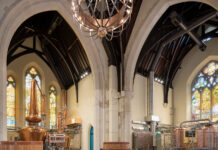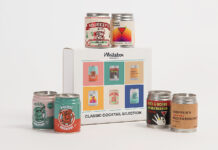The recipe for the Aviation cocktail was first recorded in Hugo R Ensslin’s 1916 book, Recipes for Mixed Drinks.
- ⅓ Lemon Juice
- ⅔ El Bart Gin
- 2 dashes Maraschino
- 2 dashes Crème de Violette
- Shake well in a mixing glass with cracked ice, strain and serve.
Readers may have picked up on the inclusion of “El Bart Gin,” something that is rather obscure for modern-day drinkers. This mention raises some questions: Who made it? Was it a brand or a style of gin? Why does Ensslin call for it by name? There is very little information about El Bart Gin, but an old label states that it is:
“Distilled and manufactured after the process of Sceats & Willis of The Camberwell Distillery, Addington Square, London, England.”
“Distilled and Bottled by Wilson Distilling Co. Inc.”
The story begins in the U.K. at the Camberwell Distillery. The earliest known reference to the distillery is from June 1867, when a cricket match took place between the Beaufoys and Camberwell Distillery companies. Camberwell won.
The distillery continues to appear in newspapers throughout the 19th century. In 1882, a newspaper article mentions a fatal accident in which a boy was hit in the chest with a hogshead barrel; at this time Pugh & Co. were operating the distillery at Camberwell.
On August 15, 1892, the partnership between Thomas Owen Pugh and William Gower Poole, who were trading as “Distillers and Wine and Spirits Merchants” under the name T.O. Pugh & Co., was dissolved and renamed T.O. Pugh. Three years later, the Camberwell Distillery, along with the Peckham Road Brewery and 13 license houses (pubs), were sold by Pugh to The Kingsbury Brewery Company Ltd.
In 1898, the distillery was sold again, to Mr. Basil Lyte Willis, who formed a partnership with a Mr. Sceats and began trading as Sceats & Willis. The pair purchased the distillery solely to undertake “grogging,” which was the process of extracting spirit trapped in the wood of old whiskey casks.
Later in the same year, Parliament passed the Finance Act, 1898, which made grogging illegal, largely because duty was not being charged on the recovered spirit. Without the ability to grog, Willis’s business model was not profitable and the distillery was sold at a heavy loss in 1901. In September 1903, Sceats died, and in November 1904, Willis filed for bankruptcy.
At this time, it seems likely that the distillery’s gin recipe was sold to an American company, Wilson Distilling. By 1910, the Camberwell Distillery had closed operations and was home to a facility that made canned food. The building has since been demolished. A park now sits on the site.
A 1914 advert for El Bart Gin states that its provenance goes back to 1784 and that the gin was being made at the Camberwell Distillery until 1904, although it is currently not possible to authenticate these dates. There is no record of the gin ever having been manufactured under the El Bart name in the U.K., and the name would certainly not be in keeping with those of other British gins of the time.
The first El Bart Gin advert appears in New York in 1905. It was described as the flag brand, with a logo that looked something like a navy pennant. At this point, El Bart Gin was manufactured by the Wilson Distilling Company of Baltimore, MD; this was founded in December 1898 as a successor to the Ulman-Goldsborough Company. Wilson also had connections to premises in Bristol, Pennsylvania, but the gin was produced in Maryland.
Adverts from the time describe the gin as being dry and clean, triple-distilled and made from grain. The commercials proclaim that El Bart Gin is good for Rickeys and other cocktails, that it is pure, fragrant and straight, and that it is the dryest gin. All of this points to a gin that had a very classic character, was unsweetened and was clean due to its grain base. The number of botanicals used was probably between four and eight.
By 1914 and the start of the First World War in Europe, supplies of British gin were being disrupted and those that were available had been victim to great price inflation. Previously, El Bart was only about 5–10% cheaper than the imported gins, but during the First World War, El Bart was one of the only “London
Dry Gins” available, and as such it gained great popularity. It is probably because of this that Hugo Ensslin chose it for his book.
After the First World War and then Prohibition, El Bart saw an increase in domestic competition from the likes of Fleischmann’s and Seagram’s. In September 1943, the Wilson Distilling Co. merged with the Hunter Distilling Co. to create the Hunter-Wilson Distilling Co., which was an affiliate of Frankfort Distillers. The general manager was Jay Gould. By 1946, production of the gin had moved to Frankfort Distillers in Kentucky, where it was bottled at 94.4 proof; a 90-proof version was also available. By 1953, El Bart Gin was being sold off at “close out” (product discontinued) prices by liquor stores and, shortly afterward, the gin disappeared altogether. In 1955, Hunter-Wilson closed its last premises in Pennsylvania, a barrel plant that coopered for Seagram’s whiskey and relocated to Kentucky.
~ A Gin Nearly Forgotten ~
Ensslin’s book has more than 30 drinks that call for El Bart Gin, but there are no El Bart advertisements printed in his book, thought there are advertisements for whiskey, beer, wine and mixers. This leads to the assumption that he genuinely appreciated the product. If he hadn’t called for the gin in so many iconic cocktails such as the Aviation and the Alexander, it is likely that the brand would have been forgotten like so many others.
All of the other recipes that use gin call for Holland or Old Tom Gin, or the occasional “dry gin,” which can be easily interpreted to mean El Bart Gin, as it was the only dry gin available at the time.
The only drink that differs is the Allied cocktail, which is a mix of equal parts French Vermouth and English Gin, with two dashes of Russian Kummel — a nice nod to the forces battling the Central Powers in the Great War. English gin is an understandable choice in this cocktail, but also an interesting one, given that few gins encapsulate the special Anglo-American relationship quite like El Bart.
David T. Smith is a UK-based writer and gin specialist. A keen supporter of craft distilling worldwide, David co-authored The Craft of Gin, and is the author of How to Make Gin and Forgotten Spirits and Long Lost Liqueurs. David has taught gin distilling classes on both sides of the Atlantic. He is a judge, predominantly of gin and vodka, on various international spirits competition panels.








